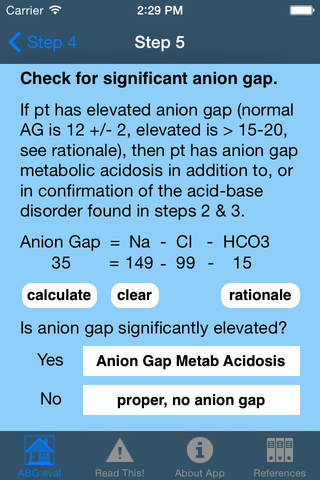
ABG Acid-Base eval walks a clinician through a stepwise approach to analyse ABGs and electrolytes in order to arrive at acid-base disorders and diagnostic ideas about ill patients. It is based mainly upon a worksheet developed by Dr. Erik Rupard from the medical literature. This tool not only yields answers, but just as importantly teaches the stepwise thinking process and the necessary concepts along the way. A clinician or learner will wind up with good information that assists patient care and should wind up a little smarter and more able to do it with less assistance the next time. It is a great support for those of us clinicians who use these tests only occasionally and dont have it memorized. The differential diagnoses include the classic mnemonics like MUDPILERS, CHAMPS, CLEVER PD, and HARDUPS, with explanations and examples.
The app addresses such common questions as:
* What are common causes of metabolic acidosis? respiratory alkalosis?
* How do I calculate predicted pCO2? corrected bicarbonate?
* What is the primary acid-base disorder?
* Are additional acid-base disorders present, and if so, what are they?
This app is written and intended for practicing clinicians like internists, family physicians, ER docs, cardiologists, pulmonologists, intensivists, and hospitalists; for resident physician trainees; for medical students; and of course for other clinician colleagues like NPs and PAs. As an educator and clinician, I am interested in feedback and I would be grateful for guidance on improving the tool.
Notes of importance:
- many thresholds and cutoffs are arbitrary and debatable, so you will have to use judgment to interpret which disorders are present and to what extent when suggested by the app
- the app facilitates you to evaluate the data. If you make a mistake, the app will not argue with you. It will, at the end, offer to compare your work to the disorders that the app finds using the same algorithm
- patients are more than the sums of their numbers and data, and they are often unique individuals. Use this information as a starting point in the evaluation of your patient and always do your own thinking!



